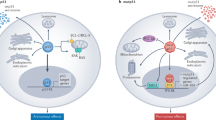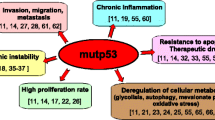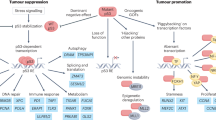Abstract
Thep53 gene is frequently mutated in human tumours and therefore an important target for therapeutic intervention. Several p53-based strategies for treatment of cancer are currently under development.p53 gene therapy has resulted in tumour regression in patients with lung cancer. A mutant adenovirus can obliterate tumour cells carrying mutant p53 or lacking p53, but is unable to replicate in normal cells. Furthermore, current studies suggest that reactivation of mutant p53 proteins in tumours using small p53-activating molecules may initiate p53-dependent apoptosis and thus eliminate the tumour.
Similar content being viewed by others
References
Ko LJ, Prives C. p53: puzzle and paradigm.Genes Dev 1996;10: 1054–1072.
Hupp TR, Meek DW, Midgley CA, Lane DP. Regulation of the specific DNA binding function of p53.Cell 1992;71: 875–886.
Selivanova Get al. The single stranded DNA end binding site of p53 coincides with the C-terminal regulatory region.Nucleic Acids Res 1996;24: 3560–3567.
El-Deiry WSet al. WAF1, a potential mediator of p53 tumor suppression.Cell 1993;75: 817–825.
Harper JW, Adami GR, Wei N, Keyomarsi K, Elledge SJ. The p21 Cdk-interacting protein Cip1 is a potent inhibitor of G1 cyclin-dependent kinases.Cell 1993;75: 805–816.
Sherr CJ. Cancer cell cycles.Science 1996;274: 1672–1677.
Smith MLet al. Interaction of the p53-regulated protein Gadd45 with proliferating cell nuclear antigen.Science 1994;266: 1376–1380.
Hermeking Het al. 14-3-3σ is a p53-regulated inhibitor of G2/M progression.Mol Cell 1997;1: 3–11.
Miyashita T, Reed JC. Tumor suppressor p53 is a direct transcriptional activator of the human bax gene.Cell 1995;80: 293–299.
Knudson CMet al. Bax-deficient mice with lymphoid hyperplasia and male germ cell death.Science 1995;270: 96–99.
Yin C, Knudson CM, Korsmeyer SJ, Van Dyke T. Bax suppresses tumorigenesis and stimulates apoptosisin vivo.Nature 1996;385: 637–640.
Buckbinder Let al. Induction of the growth inhibitor IGF-binding protein 3 by p53.Nature 1995;377: 646–649.
Owen-Schaub LBet al. Wild type human p53 and a temperature-sensitive mutant induce fas/APO-1 expression.Mol Cell Biol 1995;15: 3032–3040.
Polyak K, Xia Y, Zweier JL, Kinzler KW, Vogelstein B. A model for p53-induced apoptosis.Nature 1997;389: 300–305.
Chen X, Ko LJ, Jayaraman L, Prives C. p53 levels, functional domains, and DNA damage determines the extent of the apoptotic response of tumor cells.Genes Dev 1996;10: 2438–2451.
Walker KK, Levine AJ. Identification of a novel p53 functional domain that is necessary for efficient growth suppression.Proc Natl Acad Sci USA 1996;93: 15335–15340.
Sakamuro D, Sabbatini P, White E, Prendergast GC. The polyproline region of p53 is required to activate apoptosis but not growth arrest.Oncogene 1997;15: 887–898.
Wu X, Bayle H, Olson D, Levine AJ. The p53-mdm2 autoregulatory loop.Genes Dev 1993;7: 1126–1132.
Haupt Y, Maya R, Kazaz A, Oren M. Mdm2 promotes the rapid degradation of p53.Nature 1997;387: 296–299.
Kubbutat MHG, Jones SN, Vousden KH. Regulation of p53 stability of Mdm2.Nature 1997;387: 299–303.
Cho Y, Gorina S, Jeffrey PD, Pavletich NP. Crystal structure of a p53 tumor suppressor-DNA complex: understanding tumorigenic mutations.Science 1994;265: 364–355.
Vousden KH. Interactions of human papilloma virus transforming proteins with the products of tumor suppressor genes.FASEB J 1994;7: 872–879.
Selivanova G, Wiman KG. p53: a cell cycle regulator activated by DNA damage.Adv Cancer Res 1995;66: 143–180.
Eckner Ret al. Molecular cloning and functional analysis of the adenovirus E1A-associated 300kD protein (p300) reveals a protein with properties of a transcriptional adaptor.Genes Dev 1994;8: 869–884.
Gu W, Shi X-L, Roeder RG. Synergistic activation of transcription by CBP and p53.Nature 1997;387: 819–823.
Lill NL, Grossman SR, Ginsberg D, DeCaprio J, Livingston DM. Binding and modulation of p53 by p300/CBP coactivators.Nature 1997;387: 823–827.
Lowe SW, Ruley HE. Stabilization of the p53 tumor suppressor is induced by adenovirus E1A and accompanies apoptosis.Genes Dev 1993;7: 535–545.
Debbas M, White E. Wild type p53 mediates apoptosis by E1A which is inhibited by E1B.Genes Dev 1993;7: 546–554.
Roth JAet al. Retrovirus-mediated wild-type p53 gene transfer to tumors of patients with lung cancer.Nat Med 1996;2: 985–991.
Haupt Y, Rowan S, Oren M. p53-mediated apoptosis in HeLa cells can be overcome by excess pRB.Oncogene 1995;10: 1563–1571.
Sandig Vet al. Adenovirally transferred p16INK4a and p53 genes cooperate to induce apoptotic tumor cell death.Nat Med 1997;3: 313–319.
Yew PR, Berk AJ. Inhibition of p53 transactivation required for transformation by adenovirus early E1B protein.Nature 1992;357: 82–85.
Bischoff JRet al. An adenovirus mutant that replicates selectively in p53-deficient human tumor cells.Science 1996;274: 373–376.
Heise Cet al. ONYX-015, an E1B gene-attenuated adenovirus, causes tumor-specific cytolysis and antitumoral efficacy that can be augmented by standard chemotherapeutic agents.Nat Med 1997;3: 639–645.
Lowe SW. Progress of the smart bomb cancer virus.Nat Med 1997;3: 606–608.
Halazonetis TD, Davis LJ, Kandil AN. Wild type p53 adopts a ‘mutant’-like conformation when bound to DNA.EMBO J 1993;12: 1021–1028.
Halazonetis TD, Kandil AN. Conformational shifts propagate form the oligomerization domain of p53 to its tetrameric DNA binding domain and restore DNA binding to select mutant p53.EMBO J 1993;12: 5057–5064.
Waterman JLF, Shenk JL, Halazonetis TD. The dihedral symmetry of the p53 tetramerization domain mandates a conformational switch upon DNA binding.EMBO J 1995;14: 512–519.
Hupp TR, Lane DP. Allosteric activation of latent p53 tetramers.Curr Biol 1994;4: 865–875.
Takenaka I, Morin F, Seizinger BR, Kley N. Regulation of the sequence-specific DNA binding function of p53 by protein kinase C and protein phosphatases.J Biol Chem 1995;270: 5405–5411.
Gu W, Roeder RG. Activation of p53 sequence-specific DNA binding by acetylation of the p53 C-terminal domain.Cell 1997;90: 595–606.
Hupp TR, Sparks A, Lane DP. Small peptides activate the latent sequence-specific DNA binding function of p53.Cell 1995;83: 237–245.
Waterman MJF, Stavridi ES, Waterman JLF, Halazonetis TD. ATM-dependent activation of p53 involves dephosphorylation o and association with 14-3-3 proteins.Nat Genet 1998;19: 175–178.
Hupp TR, Meek DW, Midgley CA, Lane DP. Activation of the cryptic DNA binding function of mutant forms of p53.Nucleic Acids Res 1993;21: 3167–3174.
Abarzua Pet al. Restoration of the transcription activation function to mutant p53 in human cancer cells.Oncogene 1996;13: 2477–2482.
Abarzua P, LoSardo JE, Gubler ML, Neri A. Microinjection of monoclonal antibody PAb421 into human SW480 colorectal carcinoma cells restores the transcription transactivation function to mutant p53.Cancer Res 1995;55: 3490–3494.
Selivanova Get al. Restoration of the growth suppression function of mutant p53 by a synthetic peptide derived from the p53 C-terminal domain.Nat Med 1997;3: 632–638.
Wieczorek AM, Waterman JLF, Waterman MJF, Halazonetis TD. Structure-based rescue of common tumorderived p53 mutants.Nat Med 1996;2: 1143–1146.
Barinaga M. From bench top to bedside.Science 1997;278: 1036–1039.
Author information
Authors and Affiliations
Corresponding author
Rights and permissions
About this article
Cite this article
Wiman, K.G. New p53-based anti-cancer therapeutic strategies. Med Oncol 15, 222–228 (1998). https://doi.org/10.1007/BF02787204
Received:
Accepted:
Published:
Issue Date:
DOI: https://doi.org/10.1007/BF02787204




